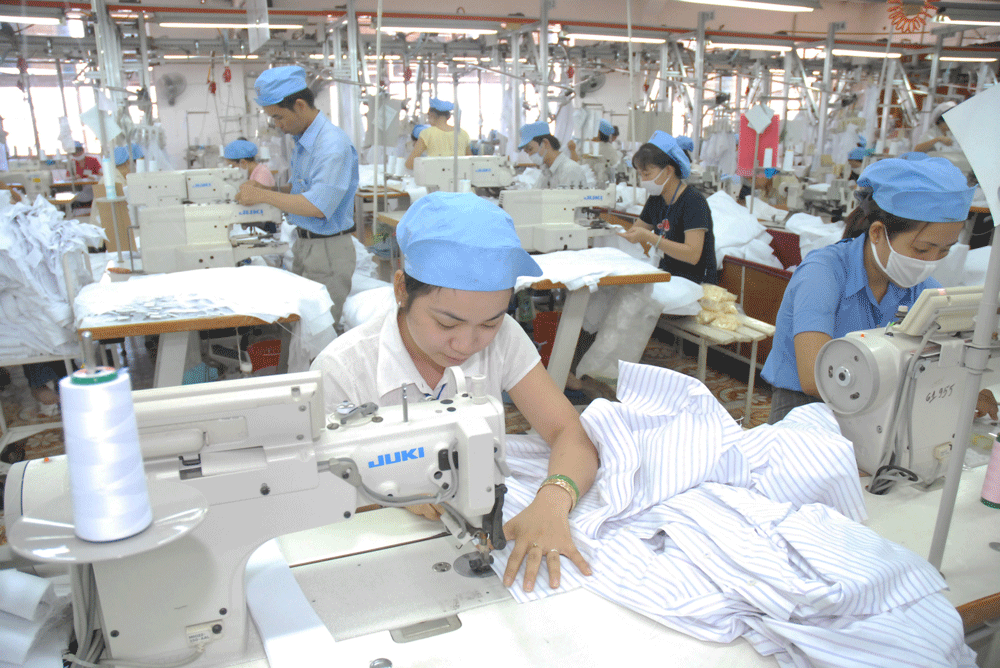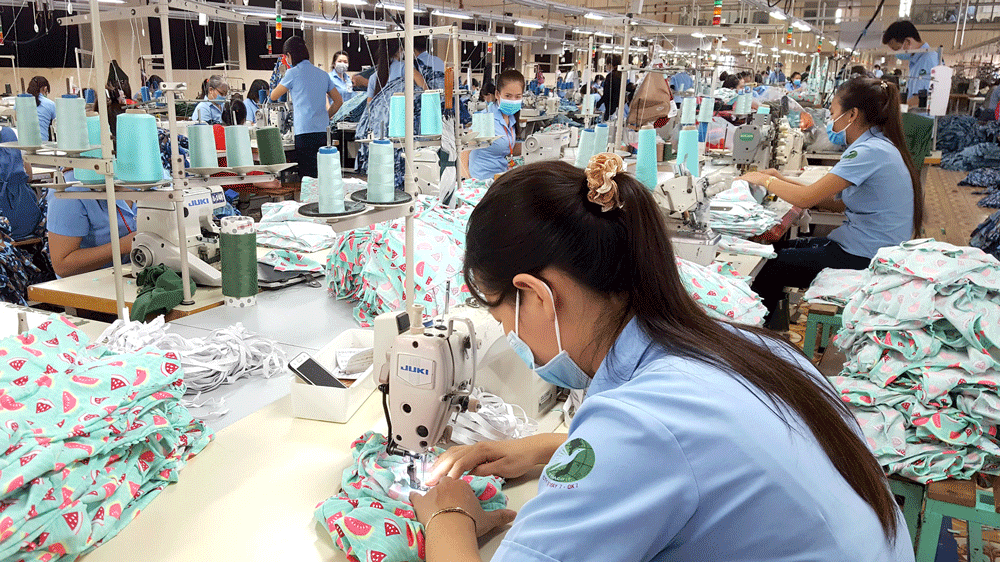
According to the Ministry of Industry and Trade, in the past six months, due to the impacts of the Covid-19 pandemic, garment and textile export turnover merely reached $12.8 billion, of which, garment and textile exports to the European market exceeded $2 billion. Last year, the total garment and textile export turnover reached around $39 billion, of which, the European market contributed more than $8 billion. Currently, the EU has become the third-largest garment and textile importer of Vietnam after the US and Japan.
However, according to the evaluation of textile enterprises, currently, garment and textile exports to the EU are still quite modest compared to the potential of this market. The reason is that Vietnam's textile and apparel products exported to the EU are imposed extremely high import tariffs. Mr. Pham Van Viet, Chairman of the Board of Directors of Viet Thang Jean Company shared that denim products of this company exported to the EU are currently subject to a tax rate of up to 16 percent. Meanwhile, on average, Vietnam's garment products exported to this market are levied a tax rate of about 9 percent.
High tax rates and high labor costs in the past two years have weakened the competitive advantage of Vietnam's textile and garment products compared to those of Myanmar, Laos, Cambodia, India, and Bangladesh. The representative of the Vietnam Textile and Apparel Association emphasized that to maintain the market share in the European market, many domestic garment and textile enterprises have turned to process sophisticated products that require higher skills. A few enterprises with large internal capital capacity have switched to designing, manufacturing, and selling branded products. However, the complicated situation of the pandemic since the beginning of this year has led to a sharp drop in the number of textile export orders. On the other hand, it has also changed the consumption trend of textiles in the third and fourth quarters of this year. The market will likely recover basic textile products with low or average value. Thereby, textile enterprises in this segment will take the upper hand in the number of orders in the global supply chain.
The fact that the National Assembly ratified the EVFTA which will become effective as of August 1 is a large opportunity for the garment and textile industry. Because, according to the commitments of the EVFTA, among key export products of Vietnam into the EU, garment and textile products will be removed import tariffs on 77.3 percent of export turnover for five years, and import tariffs on the rest 22.7 percent of exports will also be eliminated after seven years.
Besides enjoying duty incentives, the EVFTA promises to provide Vietnamese textile and apparel enterprises the opportunity to import high-quality machinery and access to raw materials under the European standards.
However, according to the evaluation of textile enterprises, currently, garment and textile exports to the EU are still quite modest compared to the potential of this market. The reason is that Vietnam's textile and apparel products exported to the EU are imposed extremely high import tariffs. Mr. Pham Van Viet, Chairman of the Board of Directors of Viet Thang Jean Company shared that denim products of this company exported to the EU are currently subject to a tax rate of up to 16 percent. Meanwhile, on average, Vietnam's garment products exported to this market are levied a tax rate of about 9 percent.
High tax rates and high labor costs in the past two years have weakened the competitive advantage of Vietnam's textile and garment products compared to those of Myanmar, Laos, Cambodia, India, and Bangladesh. The representative of the Vietnam Textile and Apparel Association emphasized that to maintain the market share in the European market, many domestic garment and textile enterprises have turned to process sophisticated products that require higher skills. A few enterprises with large internal capital capacity have switched to designing, manufacturing, and selling branded products. However, the complicated situation of the pandemic since the beginning of this year has led to a sharp drop in the number of textile export orders. On the other hand, it has also changed the consumption trend of textiles in the third and fourth quarters of this year. The market will likely recover basic textile products with low or average value. Thereby, textile enterprises in this segment will take the upper hand in the number of orders in the global supply chain.
The fact that the National Assembly ratified the EVFTA which will become effective as of August 1 is a large opportunity for the garment and textile industry. Because, according to the commitments of the EVFTA, among key export products of Vietnam into the EU, garment and textile products will be removed import tariffs on 77.3 percent of export turnover for five years, and import tariffs on the rest 22.7 percent of exports will also be eliminated after seven years.
Besides enjoying duty incentives, the EVFTA promises to provide Vietnamese textile and apparel enterprises the opportunity to import high-quality machinery and access to raw materials under the European standards.
 Many textile and apparel enterprises are rapidly changing production to approach closer to the European market. (Photo: SGGP)
Many textile and apparel enterprises are rapidly changing production to approach closer to the European market. (Photo: SGGP)
With the aforesaid opportunities, many textile and garment enterprises are ready to take advantage of the tariff incentives when the agreement comes into effect. Many enterprises have invested in all facilities from factories, and machinery to technology, to meet the technical standards of importers. According to Mr. Tran Nhu Tung, member of the Board of Directors of Thanh Cong Textile Garment Investment Trading Joint Stock Company (TCM), with what that the EVFTA will bring, as well as the potential that TCM currently has, the company aims to achieve an increase of 30-50 percent in exports into the EU in the next few years. To realize the opportunities that the EVFTA brings, TCM has built a textile dyeing factory in Hoa Phu Industrial Park in Vinh Long Province with more than 1,500 employees. It is estimated that this factory provides enough fabric for the company's production needs each year. In the longer term, TCM is expected to promote the opening of another factory in the West of Vietnam to be able to take initiative in raw materials for its production. Similarly, some garment enterprises in Ho Chi Minh City have already prepared factories, machinery, technologies, as well as raw materials, and auxiliary materials to grasp the opportunities from the EVFTA.
Mr. Pham Van Viet, Chairman of the Board of Directors of Viet Thang Jean Company, said that since the EVFTA was signed, Viet Thang Jean has signed long-term procurement of raw materials from partners in South Korea and Turkey to replace raw materials from China to meet the requirements of the rules of origin according to the commitments of the EVFTA.
However, it must be admitted that there are only a few enterprises that can meet the requirements like TCM or Viet Thang Jean. Because for many years, the garment and textile industry still depends largely on raw materials and supplies imported from China and this material has not been accepted by the European market. To overcome this, the Ho Chi Minh City Textile and Garment - Embroidery Association said that for non-processing enterprises, there are two options. First, they either produce fabric by themselves or buy domestic raw materials. Secondly, they should import raw materials from countries with bilateral trade agreements with the EU such as South Korea and Turkey.
Another problem of the textile and garment industry is that many enterprises exporting to the EU are small and medium-sized enterprises with limited resources and their production processes have not met the European standards. They have not invested adequately in researching and developing products, have not effectively exploited the intellectual property assets and trademarks. They lack human resources with foreign language skills and professional trade negotiation skills to carry out export activities to the EU market.
Therefore, what Vietnamese businesses need to do immediately is to invest in increasing the value and quality of products to enhance competitiveness in the EU market. Enterprises need to meet the standards and the management process prescribed by the EU, attach importance to social responsibility, make transparent information on labor and production environment, especially ensure the rules of origin.
Mr. Pham Van Viet, Chairman of the Board of Directors of Viet Thang Jean Company, said that since the EVFTA was signed, Viet Thang Jean has signed long-term procurement of raw materials from partners in South Korea and Turkey to replace raw materials from China to meet the requirements of the rules of origin according to the commitments of the EVFTA.
However, it must be admitted that there are only a few enterprises that can meet the requirements like TCM or Viet Thang Jean. Because for many years, the garment and textile industry still depends largely on raw materials and supplies imported from China and this material has not been accepted by the European market. To overcome this, the Ho Chi Minh City Textile and Garment - Embroidery Association said that for non-processing enterprises, there are two options. First, they either produce fabric by themselves or buy domestic raw materials. Secondly, they should import raw materials from countries with bilateral trade agreements with the EU such as South Korea and Turkey.
Another problem of the textile and garment industry is that many enterprises exporting to the EU are small and medium-sized enterprises with limited resources and their production processes have not met the European standards. They have not invested adequately in researching and developing products, have not effectively exploited the intellectual property assets and trademarks. They lack human resources with foreign language skills and professional trade negotiation skills to carry out export activities to the EU market.
Therefore, what Vietnamese businesses need to do immediately is to invest in increasing the value and quality of products to enhance competitiveness in the EU market. Enterprises need to meet the standards and the management process prescribed by the EU, attach importance to social responsibility, make transparent information on labor and production environment, especially ensure the rules of origin.
























